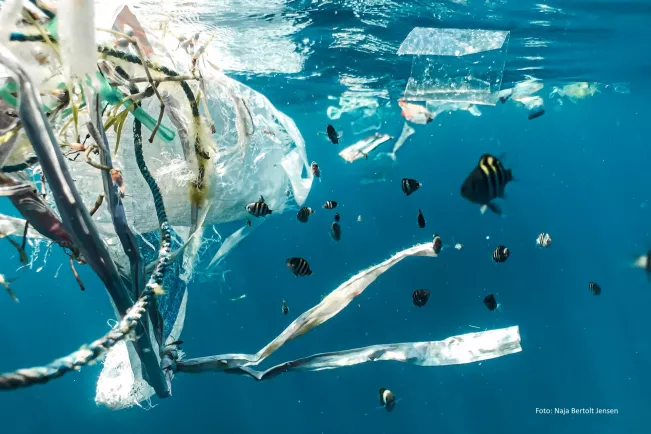Institute of Technology, Resource and Energy-efficient Engineering (TREE)
H-BRS in brief: Professor Johannes Steinhaus on the environmental impact of microplastics

"Washing synthetic clothes is a major source of microplastics"
H-BRS: Professor Steinhaus, let's talk about football: The jersey worn by the players of the German team apparently secretes an average of 68,000 microplastic fibres in the first five washes. This was discovered by the Microplastics Research Group at the University of Hamburg. Does that surprise you?
Johannes Steinhaus: No, not quite. The figure of 68,000 is indeed unusually high, and the manufacturer would do well to find out why this is the case. However, we all wash a lot of clothes made of synthetic fibres such as polyester, acrylic, nylon or elastane. The fibres that rub off in the process - typically closer to 2,000 fibres per garment and wash - enter our sewage treatment plants unhindered and subsequently end up partly in sewage sludge and partly in our waterways. The reason is that the fibres are difficult to filter out of the wastewater due to their size. Since sewage sludge is also readily spread as fertiliser on arable land, it can be assumed that a large proportion of these fibres end up in the environment. The washing of synthetic garments is the main source of secondary microplastics, i.e. produced by the abrasion and decomposition of larger plastic products.
H-BRS: What does this mean for the environment? And what could a solution look like?
Steinhaus: The effects of all these microplastic fibres on the various ecosystems are still rather unclear. The annoying thing is that one would simply have to equip all washing machines with a filter system that would prevent the entry of the fibres right from the start. But since washing machine manufacturers do not want to do this in anticipatory obedience - a retrofit filter costs about 80 euros - there would have to be legal requirements. Preferably EU-wide.
H-BRS: Plastics are not only found in textiles, but we encounter them in our everyday life all the time. Is the impression deceptive, or is more and more plastic being produced?
Steinhaus: No, unfortunately the impression is not deceiving. According to Statista, at the turn of the millennium we were producing about 200 million tonnes of plastic per year worldwide. Today, the quantities have roughly doubled with a linear trend. One major factor is certainly the unbroken trend of packaging goods in plastic.
H-BRS: Our supermarkets in particular are full of plastic packaging. Since we dutifully throw everything into the yellow bin: Is the mass of packaging recycled?
Steinhaus: One might think. However, a large part of plastic waste is unfortunately still incinerated. The amount of plastic entering the environment in our latitudes is certainly lower than in Asia or South America, for example, due to waste management. However, we certainly do not dispose of everything correctly in Europe, as can be seen from our environment. Moreover, we tend to forget that we generate huge amounts of microplastics through tyre wear and washing wastewater. In addition, we export large quantities of plastic waste to Southeast Asia. That is the part that is difficult or impossible to recycle. There, the waste is not recycled properly, but is often dumped in wild landfills or openly incinerated. And this is how the waste from the yellow bin also ends up in our environment.
H-BRS: In your research, you deal with the analysis of microplastics and the simulation and durability analysis of rubber components, among other things. What exactly is the subject of your research and what can H-BRS contribute to solving the problem?
Steinhaus: My current research in the field of microplastics analysis relates to the processing of beach, soil and sediment samples. It is truly very difficult to compare the many studies on the microplastic load of samples taken worldwide, because the sample preparation was partly carried out under very different conditions and also the so-called recovery rate of the microplastic particles varies significantly. In cooperation with the Alfred Wegener Institute/Helmholtz Centre for Polar and Marine Research in Bremerhaven, we are working on developing the simplest possible methods that can be implemented anywhere in the world.
Interview: Martin J. Schulz
Information for journalists: Prof. Dr. Johannes Steinhaus is available as a contact person for interviews on the topic of (micro)plastics. You can reach him at johannes.steinhaus@h-brs.de.
About the professor